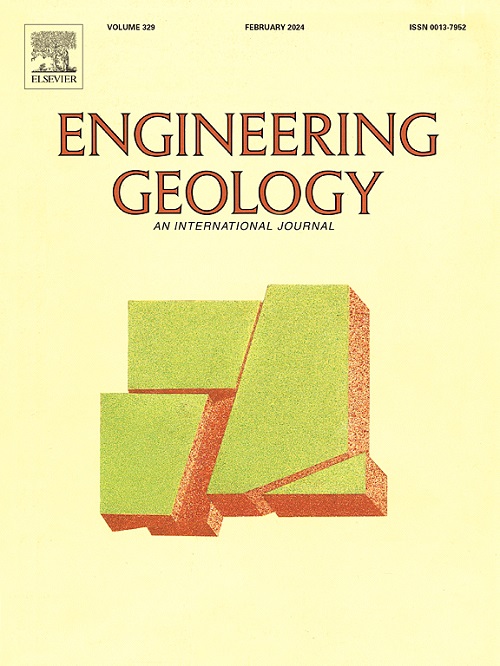一种创新的自修复地聚合物垂直屏障在干湿循环下的耐久性
IF 8.4
1区 工程技术
Q1 ENGINEERING, GEOLOGICAL
引用次数: 0
摘要
微胶囊在开发更耐用、更可靠的截流壁材料方面具有很大的潜力。本研究以硅酸钠为核心材料制备了单壁和双壁两种类型的微胶囊,具有良好的化学结构、热稳定性和流变性能。在此基础上合成了一种新型的自修复地聚合物防渗墙回填体(SHGCWB)。通过干湿循环试验对其耐久性演化进行宏观评价。通过MIP和SEM-EDS测试,揭示了微胶囊的自愈效果和耐久性增强机理。在第4个干湿循环之前,SHGCWB的水力传导率可以保持在1E-8 m/s以下,在后续循环中,水力传导率在1E-8 m/s左右波动。渗透率的真正决定因素是微孔的比例(<;0.05 μm)、中孔(0.05 ~ 0.1 μm)和大孔(>;0.1μm)。根据超声脉冲速度(UPV)和第一超声脉冲幅值(UPA)可以快速估算出SHGCWB的水力导电性。该研究为进一步提高防渗墙的长期耐久性和使用寿命提供了新的技术解决方案。本文章由计算机程序翻译,如有差异,请以英文原文为准。
Durability of an innovative self-healing geopolymer vertical barrier under dry-wet cycles
Microcapsules have great potential in developing more durable and reliable cutoff wall materials. This study produced two types of microcapsules, including single-walled and double-walled, using sodium silicate as the core material, which demonstrated advantageous chemical structures, thermal stability, and rheological properties. An innovative self-healing geopolymer cutoff wall backfill (SHGCWB) has been synthesized based on this. The evolution of durability was evaluated macroscopically through dry-wet cycle test. The self-healing effect and durability enhancement mechanism of microcapsules were revealed microscopically by MIP and SEM-EDS tests. The hydraulic conductivity of SHGCWB can remain below 1E-8 m/s before the 4th dry-wet cycle, and fluctuate around 1E-8 m/s in the subsequent cycles. The true determinant of permeability is the proportion of micropore (< 0.05 μm), mesopore (0.05–0.1 μm), and macropore (> 0.1 μm). One can promptly estimate the hydraulic conductivity of SHGCWB based on ultrasonic pulse velocity (UPV) and the first ultrasonic pulse amplitude (UPA). This study can provide a new technical solution to further improving the long-term durability and serviceability of cutoff wall.
求助全文
通过发布文献求助,成功后即可免费获取论文全文。
去求助
来源期刊

Engineering Geology
地学-地球科学综合
CiteScore
13.70
自引率
12.20%
发文量
327
审稿时长
5.6 months
期刊介绍:
Engineering Geology, an international interdisciplinary journal, serves as a bridge between earth sciences and engineering, focusing on geological and geotechnical engineering. It welcomes studies with relevance to engineering, environmental concerns, and safety, catering to engineering geologists with backgrounds in geology or civil/mining engineering. Topics include applied geomorphology, structural geology, geophysics, geochemistry, environmental geology, hydrogeology, land use planning, natural hazards, remote sensing, soil and rock mechanics, and applied geotechnical engineering. The journal provides a platform for research at the intersection of geology and engineering disciplines.
 求助内容:
求助内容: 应助结果提醒方式:
应助结果提醒方式:


